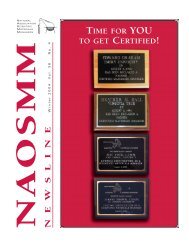Laboratory Safety Guidance
OSHA Lab Safety Guidance - ORS Optical Remote Sensing ...
OSHA Lab Safety Guidance - ORS Optical Remote Sensing ...
- No tags were found...
Create successful ePaper yourself
Turn your PDF publications into a flip-book with our unique Google optimized e-Paper software.
Xylene<br />
Exposure routes Symptoms Target Organs<br />
Inhalation; Irritation Eyes;<br />
Ingestion;<br />
of eyes,<br />
Skin;<br />
skin, nose,<br />
Skin and/or throat; Respiratory<br />
eye contact;<br />
system;<br />
Dizziness,<br />
Skin absorption. excitement, Central<br />
drowsiness, nervous<br />
incoherence, system;<br />
staggering<br />
gait;<br />
GI tract;<br />
Blood;<br />
Corneal<br />
Liver;<br />
vacuolization<br />
(cell Kidneys.<br />
debris);<br />
Anorexia,<br />
nausea,<br />
vomiting,<br />
abdominal<br />
pain;<br />
Dermatitis.<br />
Acrylamide is usually found in research laboratories<br />
and is used to make polyacrylamide gels for separations<br />
of macromolecules (e.g., DNA, proteins).<br />
Acrylamide<br />
Exposure routes Symptoms Target Organs<br />
Inhalation;<br />
Ingestion;<br />
Irritation of<br />
eyes, skin;<br />
Eyes;<br />
Skin;<br />
Skin and/or Ataxia (staggering<br />
gait), nervous<br />
Central<br />
eye contact;<br />
numb limbs,<br />
Skin absorption.<br />
system;<br />
tingling,<br />
pricking, or<br />
Peripheral<br />
numbness<br />
nervous<br />
of skin;<br />
system;<br />
Muscle<br />
Reproductive<br />
weakness;<br />
system (in<br />
animals:<br />
Absence of tumors of the<br />
deep tendon lungs, testes,<br />
reflex; thyroid and<br />
Hand sweating;<br />
adrenal<br />
glands).<br />
Tearing,<br />
Drowsiness;<br />
Reproductive<br />
effects;<br />
Potential<br />
occupational<br />
carcinogen.<br />
Employers must do the following to prevent<br />
worker exposure:<br />
Implement a written program for chemicals that<br />
workers are exposed to and that meet the requirements<br />
of the Hazard Communication standard. This<br />
program must contain provisions for worker training,<br />
warning labels and access to Material <strong>Safety</strong><br />
Data Sheets (MSDSs).<br />
Formaldehyde standard (29 CFR<br />
1910.1048)<br />
Formaldehyde is used as a fixative and is commonly<br />
found in most laboratories. The employer must<br />
ensure that no worker is exposed to an airborne<br />
concentration of formaldehyde which exceeds 0.75<br />
parts formaldehyde per million parts of air (0.75<br />
ppm) as an 8-hour time weighted average (TWA),<br />
29 CFR 1910.1048(c)(1).<br />
The Hazard Communication standard requires<br />
employers to maintain an MSDS, which manufacturers<br />
or distributors of formaldehyde are required<br />
to provide. The MSDS must be kept in an area that<br />
is accessible to workers that may be exposed to<br />
formaldehyde.<br />
Formaldehyde<br />
Exposure routes Symptoms Target Organs<br />
Inhalation; Irritation Eyes;<br />
Ingestion;<br />
of eyes, skin,<br />
Skin;<br />
nose, throat,<br />
Skin and/or respiratory Respiratory<br />
eye contact. system; system.<br />
Tearing;<br />
Coughing;<br />
Wheezing;<br />
Dermatitis;<br />
Potential<br />
occupational<br />
nasal carcinogen.<br />
Employers must provide the following to workers<br />
to prevent exposure:<br />
• Appropriate PPE, 29 CFR 1910.132, 29 CFR<br />
1910.133, and 29 CFR 1910.1048(h).<br />
• Acceptable eyewash facilities within the immediate<br />
work area for emergency use, if there is any<br />
possibility that a worker’s eyes may be splashed<br />
with solutions containing 0.1 percent or greater<br />
formaldehyde, 29 CFR 1910.1048(i)(3).<br />
1 4<br />
Occupational <strong>Safety</strong> and<br />
Health Administration



